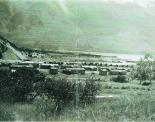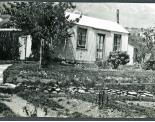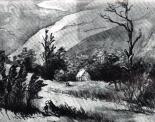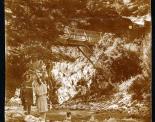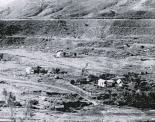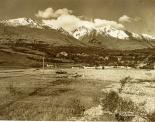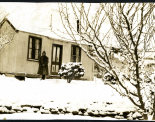CAMPBELLTOWN and THE BUCKLERBURN Gallery
CAMPBELLTOWN AND THE BUCKLERBURN
The very first place that pakeha made their camp at the Head of the Lake was on the edge of the Bucklerburn at what is today Campbelltown. Alfred Duncan, George Simpson, and Donald MacAusland, shepherds working for William Gilbert Rees, arrived with Rees’s first flock of sheep in late 1861 for Duncan and Simpson to spend the season at the Head of the Lake. Duncan (for whom Mt. Alfred is named) called the stream they crossed the Buckler Burn for his father’s home in Scotland and they spent a night camped along its banks before moving closer to today’s Glenorchy CBD to make their shepherd’s sod hut and spend a summer fighting off the rats.
A year later, in late 1862, the Bucklerburn was the place to be as gold had been found across the district and the Bucklerburn was a hive of activity with “diggers” in all kinds of mining syndicates with colourful names like The Greek, Councillor Grey and Co, the Clare Boys, and the Firebrand prospecting in the river. There were at least four pubs or hotels. J.K. Birley and Thomas Wilson, who would later have hotels in Glenorchy both may have had their hotel starts in the Bucklerburn, as either would later claim to have been in the hotel business in Glenorchy the longest. Phillip Allen ran a shop and post office, Mrs Hartley had a two-story hotel with weatherboards on the outside (quite posh!) big enough for the 20 men who came to have dinner and celebrate its opening. Tom Nunn’s hotel on the road to Glenorchy would leave its name as Nunn’s Corner for a long time to come.
A Lake Wakatip Mail article in July 1863 described the calico town in the Bucklerburn in pretty grim terms:
‘The township at the time of year, certainly does not look very promising, and reminds one strongly of Dickens’ “Garden of Eden.” The stores are pitched according to the taste and fancy of their owners totally disregarding regularity as a thing dispensable in these parts; and the waters having been up rendered this scene anything but pleasant.”
A year later, the Otago Witness found a much better scene where “with no less than four public houses with which Mr. Rees’s station and out buildings form the nucleus of the future township, a more splendid sight can hardly be imagined.” Some versions describe the Head of the Lake with a population of 300 by 1864 while others say it was closer to 100, but either way, the Bucklerburn was the place to be. At the Precipice, there was enough mining that two stores opened up out there, and the miners were spending almost as much time fishing for trout in the stream as they were fishing for gold and with about equal luck.
Gold is a fickle mistress and by 1865 when it was found on the West Coast, most of the miners headed away for richer, easier pickings, leaving the Bucklerburn so quiet that when John Trotter Butement and his family moved up to the Head of the Lake in 1866 they had their pick of deserted hotels in which they could live until their house was built. Butement’s son Thomas recollected later that his childhood friends were only the children of J.K. Birley and Thomas Wilson, both of whom had remained after the goldrush.
The Bucklerburn and Campbelltown would get a second life, though, when scheelite became a focus for mining in the 20th century. Though it had been recognized by early miners, there was little interest for the ore in the early gold rush days and it was only in the early 20th century that mining actively got underway up on Mt. Judah. During WWI and again in the 1930s scheelite prices ran high and there was great interest in it for armaments. In January 1942, the New Zealand Mines Department bought the Mt Judah and Paradise mines. The miners needed a place to live and while pre-1942 Campbelltown had been home to families like Peter and Eira Sharpe’s (whose house photos are seen here in snow and sun from 1939) in 1942 houses were put up to shelter new mine workers. Though they would only be up for two years (as the Mines Department decided to move on after 1944 when they came to the conclusion that the scheelite deposits were too small for large scale mining) during those two years, like the two years in 1863-5, Campbelltown was a booming community.
Michael Robinson, whose father Jim, was the Mining Manager for the Mines Dept. described in his memoir, “Glenorchy Lost”, what Campbelltown 1942 was like on the day he and his family arrived.
“Five large huts on each side of a single street greeted us and at its end a cluster of small huts told of where the single men lived. Of course, our arrival caused quite a stir and women and pre-school children appeared from doorways, all calling greetings to dad as they studied mum and her tribe.
We were to live in the middle hut on the mountain side of the street. Each hut was built from weatherboards, they had a single concrete chimney and a roof made from what looked like tarred cardboard. Each had a single door facing the street and two windows. The only difference between the rest and ours was the small hut that had been roughly joint to the back of ours…”
As we all know how frosty Campbelltown is in winter, we can only imagine what it would have been like for both the first gold miners and the scheelite miners and their families 80 years later.
Mary Aitken had distinct memories of arriving at Campbelltown, recently married to Brian in August 1943. “What a welcome… at Campbelltown where we were to live, there were eighteen inches of snow frozen solid and we had sixty consecutive frosts. The only water for six weeks was carried up from the Bucklerburn, milk froze, there was no electricity and men could not get up to the mine on Judah to work… Brian had a wee car, a tiny Austin, I think. One sat on the floor and he took me away up to the Judah mine and then onto the Bonnie Jean and Heather Jock.”
In this month’s photos, you’ll see a drawing done by William Rees in 1863 of a miner’s hut in the Bucklerburn, a few photos of the Eira and Peter Sharpe’s house in 1939, the Bucklerburn and Campbelltown in early times, and as it was in 1942 when the Mining Department was at its heyday. Many thanks to the Lakes District Museum for sharing their phenomenal collection of photos with us.
Does anyone know how Campbelltown got its name? If you do know, please contact Leslie or Amanda, as we can’t find a good story on how it got its name. Come to think of it, does anyone know who named Glenorchy either?


